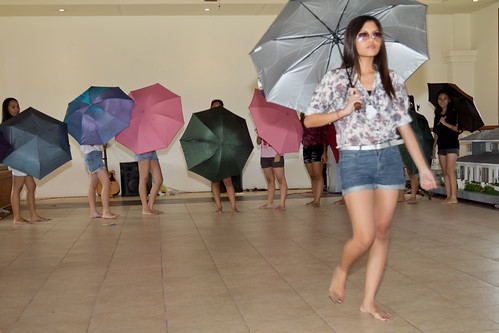If there’s one thing that most people will readily recognize that’s off about a picture is when the supposed subject of the picture is out of focus. This could be a result of the camera not being able to obtain focus (because it was too dark or the subject is a ghost in a fog) or the camera focused (through no fault of its own) on an area of higher contrast behind the subject (like the rims of the umbrella in the shot below).
To avoid ‘artsy’ (yet blurry) pictures, click on the link below to read more after the jump.
__________
Most digital cameras, be they point-and-shoot’s or DSLR’s, have a more than capable auto-focusing mechanism. If you’re on an SLR, you’ll have a number of autofocus (AF) points. On a P & S, you’ll have a box (or in more advanced models, a number of boxes). The operation is simple, you put the point or box over your subject, half depress the shutter button and the camera gives you a signal (most often a beep) that it has locked the focus in.
What many people probably don’t know is what happens when you press the shutter button halfway. The camera (with its built-in software and algorithms) will obtain both exposure and focus. Let’s not talk about exposure here as that is a whole different … dragon to contend with. Your camera needs an area of high contrast before it can obtain focus. If you’re taking the picture of a person’s face, a great area to get focus from would be the person’s eyes. If you’re taking the picture of a person in his or her environment, then you would naturally focus on the person (and not on the building behind him).
This is how I would normally obtain focus:
- I zoom in either with my lens or my feet to get the framing that I want.
- I select the AF point closest to my subject and press the shutter button halfway.
- If I can’t place an AF point over my subject, I would move my camera slightly (either up, down, left or right) to get my focus. I just take care not to move either forward or backward while I do this. Once I have it locked in, I recompose my shot.
- I then depress the button fully to get the shot.
Other people may go about it differently, but this is what works for me. I hope these tips will help you get pictures that are in focus and are sharp enough to not earn you the ire of your subjects. Or you could argue the case that the shot is intentionally out-of-focus as a means of ‘retouching’ blemishes.
More to come …

If I can’t place an AF point over my subject, I would move my camera slightly (either up, down, left or right) to get my focus. I just take care not to move either forward or backward while I do this. Once I have it locked in, I recompose my shot.
ReplyDelete*What happens when you move backward or forward? (I know you have told me the answer to this a lot of times but I kept on forgetting since I don't practice.) Btw, does a camera phone's AF mechanism capable enough too? How do I find if it is?
If you moved backward or forward, there's a good chance that from your new position the area (or plane) you intended to keep in focus would already be out of focus. There's more to it, which I could answer exhaustively in a different post. :)#
ReplyDeleteTo my knowledge, only certain phone cameras have an AF mechanism. The easiest way to find out if you're phone has it is to try to shoot a picture with it. If you half depress the shutter button and it focuses on where the box is placed over, then that would confirm the presence of that feature. If it snaps a photo right away when you do that, then it's absent.